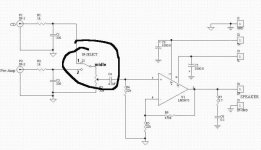I know this is the stupidest question ever, but on switches that have 3 leads, what is the 3rd for? which is which?
thanks.
thanks.
It'll depend on how u wire it..there's a NO and a NC contact (Normally Closed and Normally Open) It'll work "the other way" if you wire it incorrectly...check with a multimeter when in doubt...
elfman222 said:I know this is the stupidest question ever, but on switches that have 3 leads, what is the 3rd for? which is which?
thanks.
An example:
Attachments
that would be when u wanna have a "selector" switch...to switch between the first and second...for a power switch...just a pair of connectors (Middle and one of either side) will do...just nake sure you orientate the switch right...
You could use the switch to do an immediate A/B comparison of a "burnt in" vs a "not burnt in" power cord and and find out that there is no difference at all. 😉
it is an RC lowpass filter. off the top of my head i would assume it is to remove radio-frequency interferance from the source.
Circlotron said:You could use the switch to do an immediate A/B comparison of a "burnt in" vs a "not burnt in" power cord and and find out that there is no difference at all. 😉
you're just not wearing the right color shirt. not rocket science here.

To get technical, a switch with 3 connectors is called "dual throw". With this type of switch, the centre connector is connected to either of the other two, depending on where the switch is set. There may also be a center "off" position, where the center connector is not connected to either one. This switch may be referred to as "SPDT" (Single Pole, Dual Throw).
A switch can also have more than one "pole". Think of it as two (or more) separate switches internally that are all activated by the same rocker/lever. Such a switch may be called DPDT (Dual Pole, Dual Throw) and in this case has 6 connections.
A switch can also have more than one "pole". Think of it as two (or more) separate switches internally that are all activated by the same rocker/lever. Such a switch may be called DPDT (Dual Pole, Dual Throw) and in this case has 6 connections.
- Status
- Not open for further replies.
- Home
- Amplifiers
- Chip Amps
- Stupidest Question Ever....
